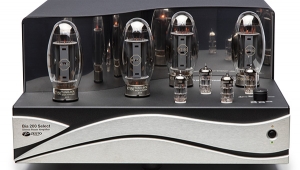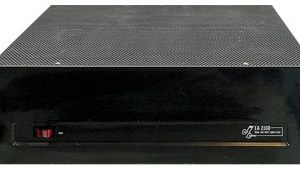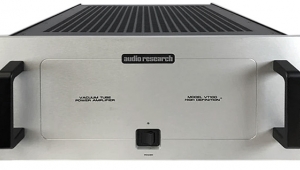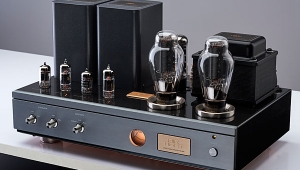| Columns Retired Columns & Blogs |
VTL Compact 160 monoblock power amplifier
 When I reviewed VTL's 25W Tiny Triodes in April 1991, I found them to be incredibly fun little suckers to play with, but got frustrated with their inability to drive my Spica Angeluses to reasonable levels with most of my recordings. I loved what I was hearing, but there wasn't nearly enough of it! As it turns out, John Atkinson was listening; not just to my plea, but also to the new VTL Compact 160 monoblocks in preparation for a full review. However, while all this was going on, David Manley decided that the power-supply voltages in the 160 weren't beefy enough to exploit his new KT90 output tubes; back the amps went for a transformerectomy.
When I reviewed VTL's 25W Tiny Triodes in April 1991, I found them to be incredibly fun little suckers to play with, but got frustrated with their inability to drive my Spica Angeluses to reasonable levels with most of my recordings. I loved what I was hearing, but there wasn't nearly enough of it! As it turns out, John Atkinson was listening; not just to my plea, but also to the new VTL Compact 160 monoblocks in preparation for a full review. However, while all this was going on, David Manley decided that the power-supply voltages in the 160 weren't beefy enough to exploit his new KT90 output tubes; back the amps went for a transformerectomy.
"Hello, VTL; May I help you?"
"Ah yes, this is John Atkinson of Stereophile calling..."
"I can't hear you; sounds like there's a handkerchief over the receiver."
"Oh, sorry...uh, it's this bloody cold I have, sod it all..."
"And what's with your accent? You sound Hungarian! Is this really JA?"
"Right-o, bird! I've decided to have a new reviewer of mine handle the Compact 160s when they're finished, so send them to Austin, Texas..."
"You're Corey Greenberg, aren't you?"
"No! Now listen, I'm a very busy man, so I don't want you calling me back here at the magazine to confirm this. I really am calling from Santa Fe...hey look! A pastel coyote wearing a bandana just walked by!"
"Okay, 'John,' we'll have those amps shipped to Corey right away. Oh, by the way—all the girls here in the office were wondering...is CG gay?"
"WHAAAT?! NO!! I'm—he's as straight as they come! Wh-what makes y'all—I mean, you—think that?!"
"Ha ha ha! Oh, nothing! Well, bye-bye, 'John'! Ha ha ha!"
"WAIT A MINUTE! What makes you th—" [click]
The end of the world is here; spare some change?
My pal Steve Melkisethian runs Savage, Maryland's Angela Instruments (footnote 1), and I had him on the phone last week when he went into his Chicken Little impression; seems he was commissioned by TAS to write a piece on the current state of tubes, and what he found was not pleasant. "It's all gonna be over in a few years, the whole tube thing," he said. "All the good plants are closing, and pretty soon there won't be any decent tubes for audio...things are moving very quickly."
Steve's right; things are moving very quickly. Many high-end audio tubes just aren't being manufactured anymore; witness the long-discontinued British M-O Valve Company KT88, considered by many to be the best-sounding output tube ever made. Today's Chinese KT88 is actually more a mutant 6550 than a true M-O clone, and even then it's got a deserved reputation for early failure. Both Philips and GE have closed down production of the 6550, again leaving the inferior Chinese version as the only currently manufactured replacement. EL34s and 6L6GCs (footnote 2), too. Why else do you think most tube amp manufacturers are designing their latest gear around seldom-used tubes like the 300B? Because they're bored? Scared is more like it.
VTL's David Manley is one manufacturer who won't take things lying down when it comes to tubes for his amplifiers; when the American 6550s he used in many of his larger amplifiers, like JGH's favored Deluxe 300s, looked in danger of extinction, he approached all the surviving tube factories about designing a new super tube; one that would be available, reliable, and sound great. Along with Yugoslavian tube manufacturer Ei's designer Blago Bukumira, Manley has introduced his very own Big Bertha, the brand new KT90 output pentode. Patterned after the early Telefunken EL156 pentode used in vintage Neumann cutting amps, the KT90 is said to be one mighty valve, able to take much higher plate and screen voltages than the Chinese tubes; David Manley claims that while the '90 is rated for 850VDC plate voltage, in actual use it can take a kilovolt! VTL currently supplies these tubes to other manufacturers designing their own KT90-based amplifiers, Jadis for example, and replacements are available from VTL dealers or direct from Chino.
Visually, the amps look much the same as the others in VTL's Compact line, with a slim black and chrome chassis and those U-shaped "unhandles" everyone uses as handles anyway. As with most of the VTL amplifiers, the input signal is taken via a short length of VTL interconnect to a 12AT7 connected with both halves in parallel for the input stage, then on to a 12BH7 for the phase inverter/driver stage. Premium Wima film caps and metal-film resistors populate the circuit board, while the B+ supply is smoothed by 1000;uF of capacitance.
Overall, I found the Compact 160's internal construction to be very good, although there are still components tack-soldered on top of printed circuit traces instead of through-hole soldered. I also found that much of the solder flux around many of the joints had been scraped off; I hope this is typical of production, and not just a "reviewer's courtesy." Surprisingly, the quartet of KT90s in the review samples are mounted with their bright red inked "VTL KT90" labels facing the rear; I would've thought that, of all people, David Manley would mount these tubes to show off his logo! On the back are the gold-plated 5-way binding posts and a rhodium-plated RCA input jack, along with a captive 3-conductor 16ga AC line cord.
It's on the front of the amp, however, where the real fun's at: the pentode/triode switch! David Manley says that from the outset of its design, the KT90 was intended to be used as both a pentode and a triode. And that's exciting news, because, as I said in my Tiny Triode review, there are triode freaks silently walking among us who won't listen to anything else; after hearing both the Tiny Triodes and the Compact 160s, I fear I may be turning into one...
Sound
When I first listened to the Compact 160s, I was kind of underwhelmed. They just didn't grab me the way the Tiny Triodes had, or the earlier generation of VTL amps like the Compact 100s. If I could sum up the "old" VTL sound, it would be "fast and exciting"; exceedingly quick transients with just a hint of added brightness that actually complemented many systems/rooms. When solid-state amps are bright, they're usually real fatiguing over the long haul, but the VTLs were bright in kind of a pleasing way, and they immediately stood out in side-by-side comparisons with other models. The Compact 160s, on the other hand, don't have this brightness; if anything, their highs are somewhat restrained in direct comparison to most other amps I've heard. Also, the dynamic capability of these amps is lower than I would've expected from a tube amp rated for 160W; I ran out of steam a couple of times with both the Spicas and the NHTs, but then I like my music a wee bit loud at times. As in all the time. The VTLs don't lose their heads like most solid-state amps when they red-line, they just start sounding a lot more forward as their tubes and output transformers start saturating.
Footnote 1: www.angela.com. Five bucks'll get you the wildest catalog around of vintage tube hi-fi gear, electric guitars, photos of naked ladies, and old Fender and Marshall amps...everything a boy could ever need. The hilarious descriptions and promotion of weird, funky gear as high art make the Angela catalog a must-have; any place that can sell me both a Fender bass and a Dynaco Stereo 70 gets my solid support!
Footnote 2: Fender just reissued their classic 4-10 Bassman guitar amplifier, and when I went down to the local music store to check it out, it sounded horrible; turns out one of the two Chinese 6L6s that came in the amp was dead. I asked the salesman if he knew that his amp was busted, and he just shrugged, "Ever since Fender switched to Chinese tubes, all their amps come in with at least one dead tube." I went home and got a pair of Russian Sovtek KT66/5881s, returned to the store, and slapped them into the Bassman; he was astounded at how much better it sounded.
- Log in or register to post comments



































